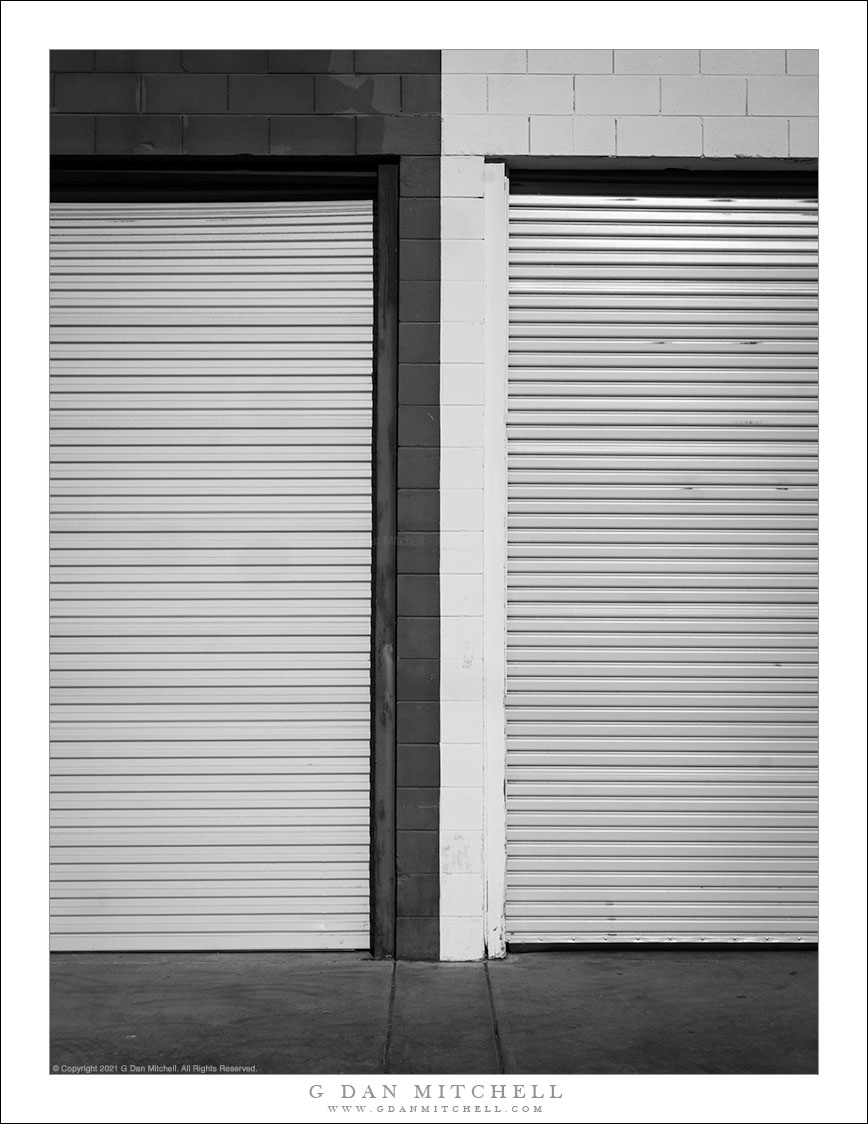
Roll-Up Doors. © Copyright 2021 G Dan Mitchell – all rights reserved.
A pair of roll-up doors on a San Jose industrial building.
Collecting quotations about photography is an occasional hobby of mine. (Making them up is, too!) One of my favorites comes from Minor White: “One should not only photograph things for what they are but for what else they are.” (There are several slightly different versions of this remark, so I suspect it is something that he referred to a lot.) This is a powerful and loaded observation, it has quite a few implications, and it points an appropriately wagging finger at those folks who seem to think that photography is nothing more than a way to “capture” things in some form imagined to be “objective.”
This is, perhaps obviously, one of those photographs of “what it is” and “what else it is.” The objective reality of this subject is pretty mundane — a pair of metal roll-up doors on a light-industrial building. I photographed it in bright, harsh sunlight, and the original includes colors not present in the monochromatic presentation I chose here. So, a couple fo doors, a bit of wall, and some dark concrete. Yet, that’s not what I really “see” when I look at this photograph — for me that “what else it is” is the main focus, to the point that I have to almost remind myself of the original subject.
G Dan Mitchell is a California photographer and visual opportunist. His book, “California’s Fall Color: A Photographer’s Guide to Autumn in the Sierra” is available from Heyday Books, Amazon, and directly from G Dan Mitchell.
Blog | About | Flickr | Facebook | Email
Links to Articles, Sales and Licensing, my Sierra Nevada Fall Color book, Contact Information.
Scroll down to leave a comment or question.
All media © Copyright G Dan Mitchell and others as indicated. Any use requires advance permission from G Dan Mitchell.
Discover more from G Dan Mitchell Photography
Subscribe to get the latest posts sent to your email.

Thanks for sharing your thoughts on photography and for the quotation from Minor White, which I agree is a powerful and insightful observation. Photography is not just about capturing what there is but also about capturing the emotions, feelings, and stories that lie behind the image. As a viewer, it’s important to go beyond the surface of the photograph and explore what else it represents. Your photo of the pair of roll-up doors on a San Jose industrial building is a great example of this. At first glance, it may seem like a simple snapshot of an everyday scene, but upon closer inspection, there are many layers of meaning and symbolism to be found. The doors themselves may represent the opening and closing of opportunities or the entrance and exit of different phases of life. The rust and wear on the doors may suggest the passage of time and the transience of all things.
Thank you for sharing your thoughtful observations. Indeed, a photograph can imply many things in addition to just being a supposed record of something. Some of these implications are intentional — I had a few such thoughts when I made the photograph of the metal doors. Some may be inadvertent and not even consciously known to the photographer.
I’ve long believed that photographs may perhaps tell us less about the things that appear in them and more about the person who made them.
Dan